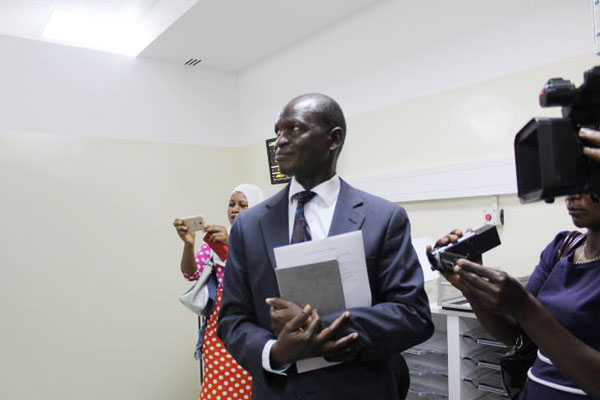
Kampala, Uganda | THE INDEPENDENT | Non-communicable diseases (NCDs) impose a heavy burden on the Ugandan population specifically the rise in the number of new Cancer cases. Cancer is one of the most common NCDs in Uganda caused by different risk factors. Annually, over 5,000 cases are registered at the Uganda Cancer Institute (UCI). Although cancer is a serious health problem, it can be prevented and controlled if detected early, as expressed by Dr. Jackson Orem, the Executive Director of Uganda Cancer Institute in this interview in the HEALTH SECTOR NEWSLETTER.
Tell us about the burden of Cancer in Uganda?
In terms of burden, we talk about three statistics.
- According to Kampala Data Registry, the incidence of cancer for every 100,000 is 320 newly diagnosed cases.
- Our conservative estimate is that at any one time, we have an excess of 200,000 cases – both new and old and even those that have been treated and cured. Once a diagnosis has been made that you have Cancer, you will always be a cancer patient. There is no graduating from that status.
- For every 100 new cases diagnosed, 80 of them cases die. We have an 80% mortality rate and 20% survival rate
What is Uganda Cancer Institute (UCI) doing about Cancer in Uganda?
UCI is doing its best. It is the only established entity where Cancer management is being done in the country. We have history, a good track record, expertise. Cancer is a highly specialized condition requiring a lot of skills.
As Uganda Cancer Institute, we have an ongoing program with Civil Societies aimed to increase awareness on Cancer. If we increase awareness, we must make sure that the product of the awareness creation accesses care. If they don’t access care, that means what you’re doing is futile.
However, we have a challenge of low access to UCI. For every 100 suspected cancer cases, only 4% make it to UCI, while 96% do not access care. This is attributed to:
- Those that don’t access care are unaware of their status
- Even if they knew their status, majority of our population stays in the countryside. According to the population, you require a number of things before you can access Uganda Cancer Institute. There are barriers known as socio economic barriers such as transport, “where will I leave my children”, “who will look after me”, “where will I stay” etc. , that hinder access to the Institute.
- Availability of drugs impacts accessibility to treatment.
Generally, the number of people who can access care is very low
What are we doing in order to mitigate low access to Uganda Cancer Institute?
If you combine the fact that it’s very difficult to access UCI in Kampala and the fact that we do not have facilities nearby, the next step is for us to decentralize.
We have started that process – we have a centre in Mbarara, another centre in Arua. We also have one community model centre which we have started in Mayuge District in Kidandalo Health Centre IV.
We have also identified places in Gulu and Mbale and we want them to grow so that they can become regional Cancer centres. That process has started off well and Government of Uganda is in the process of securing funding for us to start the centre in Gulu
What are the common causes of Cancer in Uganda?
Cancers in Uganda, as many other developing countries, are related to infection. Close to 40% of Cancers are infection related cancers such as Cancer of the cervix, cancer of the liver, Kaposi Sarcoma (cancer of the skin), Cancer of the head and neck, Lymphomas, Burkitt’s Lymphoma and we also suspect some of the Leukaemias being caused by infection.
There is a risk in our population related to lifestyle choices such as consumption of tobacco and alcohol etc. Although those types of cancer are not very high, looking at the way people are living and adopting new cultures, we should be prepared to deal with such cancers. The best thing we can do is prevent the occurrence of these cancers through increased awareness programs rather than prepare to manage them
Is cancer curable?
Yes, cancer is curable. There are three ways we can look at curing Cancer and these are:
- 30% of all cancers are curable
- 30% can be treated by palliation – Improving survival and quality of life
- 30% can be prevented – Embrace immunization against Hepatitis B, HPV etc., avoid smoking, avoid consumption of alcohol.
If we do these three things, we can effectively say we are curing cancer
On average, how many patients does the Cancer Institute receive annually?
We see between 4,500-6,000 new Cancer cases every year and these are just new patients that we add to the already existing patients at the Institute. For the patients who are already receiving treatment from the Institute, we have reached the mark of over 48,000 visits per year. This number is quite high.
Our success in terms of survival is very low and that is because of many reasons. Even if patients come and we treat them properly or we start them on treatment, some of them default on treatment or don’t come back or return when the disease has relapsed. This has led to poor statistics for us as a country.
Cancer like Burkitt’s Lymphoma is curable but our outcome in terms of survival is actually still low. We have a survival rate between 50%-75% compared to International statistics which are above 95%.
Breast Cancer which has a 5-year survival is just about 40% while for the rest of the world, it is 75-80%. We still have a long way to go. There are still a lot of gaps that need to be closed
What Cancer types are commonly presented at the institute?
Among infection related cancers, we have Kaposi Sarcoma, Cancer of the breast, Cancer of the cervix, liver, Lymphomas etc. We also have other cancers like Cancer of the oesophagus, cancer of the stomach, and Cancer of the prostate
The radiotherapy machine was recently brought into the country, are Ugandans now able to access the services?
The radiotherapy machine is already installed. By early next month (December), we should start piloting and commissioning while full blast treatment will take place in January. As we speak, we have an expert coming in from the International Atomic Agency to inspect and make sure that everything is in place as this is a very highly regulated treatment.
How were you able to manoeuvre through the period when the radiotherapy machine broke down?
Uganda Cancer Institute presented a paper at the AORTIC’s 11th International Conference on Cancer in Africa (AORTIC 2017) applauded by the participants and a number of lessons learnt from us on how we managed this breakdown.
We were able to manage because:
- We made people aware of the problem at hand
- We received support from other centers in the region. Specifically, we got support from Aga Khan Hospital in Nairobi, Kenya.
- We expedited the importation, assembling and commissioning of the equipment
All in all, the biggest game changer was how we reorganized our way of doing things. More than 75% of our patients who receive radiotherapy are usually for palliative purposes.
Uganda is well known for a well-developed Palliative Care service. We formed a committee that evaluated all our patients and then divide them into three categories which are:
- Patients who require radiotherapy at all costs – We included children and those whose cancer would be cured with radiotherapy
- Patients who if received alternative palliative care treatment will still be fine
- For patients who required both palliative care and radiotherapy, radiotherapy treatment is critical in making sure their symptoms are controlled. Such patients don’t respond to Morphine or other forms of Palliative care.
Once we had this strategy in place, we came up with a smaller population who required to travel to Nairobi for radiotherapy treatment. Aga Khan Hospital gave us a quota of 450 patients and we have treated 150 patients under this arrangement. In this period, we only lost 2 patients not because they did not receive radiotherapy but to other causes.
A word to the public?
I would like to implore fellow Ugandans to always take the prevention course. Take charge of your life by making changes such as eating a healthy diet and going for regular screening. Your chances of developing cancer are affected by the lifestyle choices you make, and thus, simple lifestyle changes can make a big difference. Do not use tobacco, eat a healthy diet, maintain a healthy weight and be physically active, if you choose to drink alcohol, do so only in moderation, limit processed meats and go for regular screening to know your status, for early detection and intervention.
** SOURCE – Health Sector Newsletter
 The Independent Uganda: You get the Truth we Pay the Price
The Independent Uganda: You get the Truth we Pay the Price



One of the best approaches against cancer is prevention. This is possible through improved local diets full of locally available foods, green vegetables and fruits in combination with known herbs. Herbal extracts are available to help the population. Many of these have been tested and results published.
Government should work with local dealers to promote establishment of medicinal gardens and plantations as part of reafforestrastion or environmental management and assist those who are providing extracts in form of supplements to assist the general population. Cancer is manageable and the statistics can be improved in the long term. Let the cancer institute reach out to alternative remedies and promote prevention in addition to current approaches.